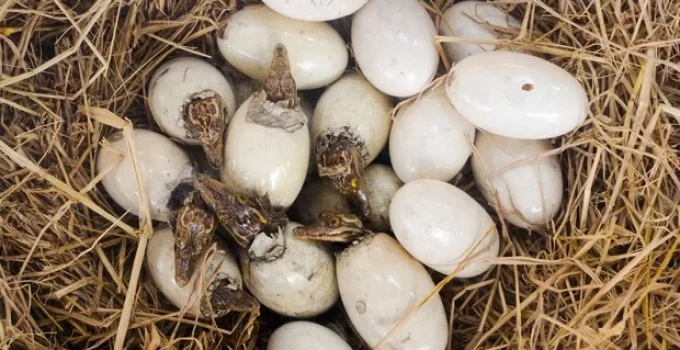Author: Gabrielle Marks
Reviewed: 5/28/2025
How Do Alligators Reproduce?
Answer at a Glance: Alligators are egg-laying reptiles that reproduce through sexual reproduction.
Dig Deeper
- Alligator Mating Rituals
- Alligators Are Intimate
- Where Do Alligators Lay Eggs?
- Temperature-Dependant Sex Determination
- How Do Baby Alligators Hatch?
- The Reproduction Cycle Begins Again
- References
Two species of alligator have remained on opposite ends of the globe since prehistoric times: the American alligator (A. mississipiensis) and the Chinese alligator (A. sinensis). The American alligator is primarily found in the southeastern United States, with the majority of its populations located in Florida and Louisiana. They primarily reside in freshwater sources, such as lakes, swamps, marshes, ponds, and rivers, but have also been found in marine environments with saltwater. [1]
Alligator Mating Rituals
The mating rituals of alligators are a fascinating reflection of their evolution over many millennia. In late spring, male alligators become more assertive in establishing their territory. To attract females, they perform unique behaviors such as slapping their heads against the water and emitting echoing grunts. Some species even gather in large groups to grunt in unison, a spectacle that can be heard from miles away. Once the females arrive, it’s a free-for-all, with each male vying for her attention.
Alligators Are Intimate
Once the alligators have paired, the courting ritual begins. The two will swim together, touch noses, and blow bubbles in the water. [2] The male alligator fertilizes the eggs inside the female with a mammal-like phallus usually kept inverted inside its cloaca. [3]
Interestingly, a new study discovered that many alligators are loyal to their mating partners. In the ten-year study, scientists found that up to 70% of female alligators choose to mate with the same partner over many years. [4]
Where Do Alligators Lay Eggs?
Generally, within a month or two, the female alligator will then begin to locate a suitable spot to lay her eggs. [5] She makes a bed of vegetative matter with her hind legs, lays her eggs in the center, and then covers them liberally with more vegetation. Called a clutch, she will lay between 20 and 60 eggs, depending on her age and health. The average clutch size is between 35 and 40 eggs. [6]
Through mid-summer, the eggs will be kept warm by the gasses produced by the rotting vegetation. Falling victim to predators and weather, fewer than 70% will survive. [7]
Temperature-Dependent Sex Determination
Unlike many reptiles whose sex is determined by sex chromosomes at the time of fertilization, the sex of the alligator is determined by the environment. During development, the temperature of the eggs plays a crucial role in determining the alligator’s sex. Lower temperatures of 86°F or below will produce a female alligator, while temperatures above 91.4°F will produce a male. Temperatures in between will produce both males and females. This unique feature of alligator biology is a testament to the complexity of nature.
How Do Baby Alligators Hatch?
In about sixty days, baby alligators are ready to hatch. They first give out a sound called a yerp to alert the mother that they are prepared to hatch. The mother will then remove the nesting material to expose the eggs. The baby alligators, called hatchlings, are now ready to break through the egg with an egg tooth, which has developed on the tip of their snouts for this purpose. The egg tooth will disappear within a few days. If the hatchling cannot free itself from the shell, the mother will roll the egg in her mouth until it cracks, freeing the hatchling. [9]
The Reproduction Cycle Begins Again
The hatchlings, living in groups called pods, are fiercely guarded by their mothers for the first two years of their lives. Despite this protection, nearly eighty percent of hatchlings fall prey to predators such as birds, raccoons, snakes, and even other alligators. This underscores the harsh realities of the alligator world. By year six, they will have reached maturity, but their sexual maturity develops in relation to their size. Both males and females reach sexual maturity when they reach a length of six feet, usually between 10 and 12 years old. At this time, the mating ritual begins again.
References
- [1][2] [6] [7] University of Florida IFAS Extension – “Living with Alligators a Florida Reality.”
- [3][5] eNature; Burton, K – “Alligator Egg Fertilization.”
- [4] Wiley News Press Release – “Loyal Alligators Display the Mating Habits of Birds.”
- [8] [9] Southern Regional Aquaculture Center-Texas A&M University; Masser M. – “Alligator Reproduction-Breeding and Egg Incubation.”
- [10] [11] Smithsonian National Zoological Park – “American Alligator Fact Sheet.”
- National Geographic – “American Alligators.”
Related Products
Alligators: The Illustrated Guide to Their Biology, Behavior, and Conservation Hardcover – Illustrated
by Kent A. Vliet (Author), Wayne Lynch (Photographer)
In this fascinating account, richly illustrated with more than 150 photographs from award-winning wildlife photographer Wayne Lynch, expert zoologist Kent A. Vliet introduces readers to the biology, ecology, and natural history of the American alligator.

